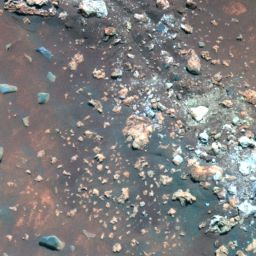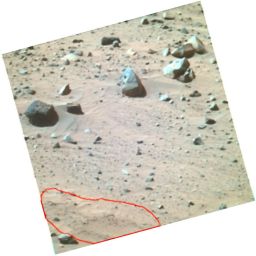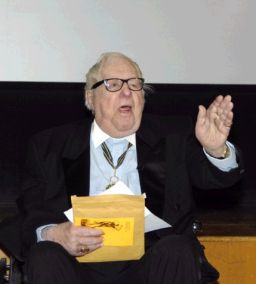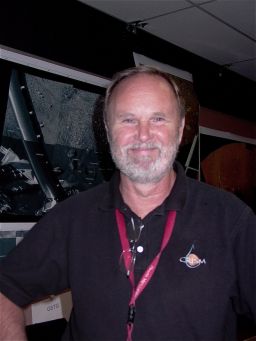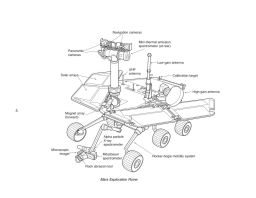Mars Exploration Rovers Update: Spirit and Opportunity Begin Sixth Year of Exploration

Written by
A.J.S. Rayl
Contributing Editor, The Planetary Society
January 31, 2009
The Mars Exploration Rover mission crossed the finish line of another major milestone this month, marking its fifth anniversary of exploring the Red Planet. As team members celebrated and shared stories in events all around Los Angeles, Spirit and Opportunity kept on roving, bucking up under the inevitable pains of growing older. They’re heading now for their next major destinations.
Five years of roving on Mars is -- both scientifically and in terms of engineering -- a tremendous, enviable achievement in planetary exploration.
The MER story is one those following the mission know well. "The idea was really very simple," remembered Steve Squyres, MER principal investigator. "Take a set of fairly straightforward geological tools, put them on a vehicle, get it to Mars, and give it a few months to drive around, from one boulder to another, see if there's some diversity there, and try to piece together what the place might once have been like."
Even though getting to Mars safely was and is extremely difficult, the simple idea translated amidst much skepticism and doubt into not one but two identical robot field geologists. Then, from technology never before seen and once not believed, the identical twins bounced to landings, one after another, on January 3 and January 24, 2004 on opposite sides of the planet, and emerged from the cocoons of their spacecraft in glorious robot fashion. Then, within weeks of their arrivals, they sent home the scientific gold -- evidence for past water at both Gusev Crater and Meridiani Planum.
Since those early, thrilling and chilling days, Spirit and Opportunity have traversed vast plains, climbed Martian "mountains," descended into deep craters, and vicariously taken the world on its first overland expedition of Mars. Although designed for a 90-day mission, they have exceeded their “warranties” by a factor of 20, somehow surviving rover-threatening dust storms and three titanium-chilling Martian winters, rewriting the textbooks virtually every step of the way.
"Spirit and Opportunity have set the benchmark really, really high," said Ray Arvidson, MER deputy principal investigator, of Washington University St. Louis, who first went to Mars on the Viking team in the mid-1970s. Although the theory that Mars was once warmer and wetter has been around for decades, it was Spirit and Opportunity that actually sent home the hard evidence. "It really took these two rovers and the ability to go to the outcrops and measure them to finally convince everybody that this planet had a lot of water in the past that interacted and affected the rocks, on both the surface and in the interior,” he pointed out.
As January gives way to February, Spirit and Opportunity are working hard to push the benchmark even higher as they press on for their next major destinations. At Gusev Crater, Spirit, which spent virtually all of 2008 parked at the circular volcanic plateau called Home Plate waiting out winter, is roving toward an unusual pit the size of a house and a mound, named for rocket pioneers Robert Goddard and Werner von Braun. These geological formations are located about 300 meters south of the rover’s location on and Spirit, despite some troublesome glitches last weekend, is preparing to take its first big rove that way today. Opportunity, meanwhile continues its epic treak to Endeavour Crater, a journey it began last September.
Once the New Year got underway, Spirit began preparing to back down the northern slope of Home Plate, following several more failed attempts to climb on top of it with its broken right front steering wheel. That means it will take more time for Spirit get to Goddard and von Braun, but having to back down could hardly be considered a loss.
As it backed down, the rover took advantage of its adversity – a broken right front wheel – and drug it over a target that intrigued the team, a lumpy little outcrop, they named for Olaf Stapledon, the philosopher and science fiction author. It looked a lot like the target where they found a deposit that was 92% silica, Spirit’s greatest find on the mission to date, As it turned out, Stapledon is more than 70% silica.
"It was important to see if there were silica-rich deposits on the north side of Home Plate, which we now know there are," said Arvidson. More than that, it's evidence that bolsters their hypothesis that Gusev Crater is a region that eons ago featured hot springs or volcanic fumarole activity, the kind of place where life might have formed.
While Spirit – which has only traveled 16.2 meters (about 53 feet) down and toward the east since moving from its winter position – could easily back all the way down Home Plate and go around to get to the southern pathway to Goddard and von Braun, the team is still hoping to get on top of Home Plate and save some time. Driving across the plateau remains the shortest, easiest way to get to the new location, north to south, particularly since this rover is so dusty it can take in only about 30% of the available sunlight for fuel and also has a broken wheel.
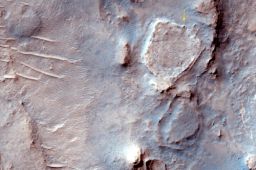 Spirit at Home
Spirit at HomeThis image shows Spirit at its winter parking spot on the northern edge of Home Plate in the Columbia Hills, at Gusev Crater. It was taken just before the southern hemisphere winter solstice at about 2 p.m. local time on the rover's Sol 1591 (June 24, 2008). Home Plate is the elevated round and light toned circular formation on the right side of the image. Spirit is visible at the large dark "dot" on the north-northeast edge of the plateau.
Credit: NASA / JPL / University of Arizona
Engineers were checking out the possibilities last weekend and were debating a couple of possible “onramps” when Spirit experienced a couple of glitches that seemed to occur out of the blue. On Sunday, January 25, Spirit's Sol 1800, the rover failed to carry out a drive and also seemed to suffer a bit of memory loss.
“It came up in what we call the crippled mode and we're still assessing what was responsible for that,” said Squyres, in an interview yesterday. “It is possible that it was due to a cosmic ray event. If it was a cosmic ray, it's a one-time event and we simply move on.”
There are other possibilities, however, and engineers are still looking into what caused Spirit’s woes last Sunday. Even though the rover carried out other assigned tasks later that same sol, it wouldn’t be the only glitch that had the MER engineers wondering this month.
Two sols or Martian days later, Spirit failed to find the Sun in a routine orientation procedure known as get fine attitude. “We are also in the process of assessing why that happened,” said Sharon Laubach, chief of the team that writes and checks commands for the rovers from their mission control at the Jet Propulsion Laboratory (JPL).
Despite some "heightened concern," as Laubach defined it, there is no panic among the team and Spirit appeared to be just fine throughout the rest of this past week. "We're taking it day by day," Laubach said. "Spirit is safe, healthy, and is talking to us. In fact, except for the glitches, the rover appears completely normal. We've had several boot-ups since then, several Odyssey passes, and uplinks. Those have all worked normally."
Whatever happened, it’s certainly not enough to stop this rover, not at this point anyway. Nor do Spirit's extreme low power levels seem to be holding it back too much.
 Winds and dust devils in Gusev Crater
Winds and dust devils in Gusev CraterThe winds that come every spring to the southern hemispher on Mars whip up dust devils, several of which are visible in this frame from a "movie" captured on Spirit's Sol 568. The same winds that conjure life-threatening condition for the rovers have also inadvertently cleared dust for the rovers' solar panels, thus allowing them to live longer and propser on the Red Panet. Dust devil movies are available on Mark Lemmon's website.Credit: NASA / JPL / Texas A&M
One reason the solar-powered robots have been able to rove so long is because of the Martian winds that blow around in springtime and inadvertently blow off much of the accumulated dust on the solar panels. While Opportunity in recent months has experienced several Martian gusts of wdust-clearing events, it's going on nearly two years since Spirit has been "dusted."
With the Sun rising higher in the Martian spring sky, "the power levels are going up a little now on Spirit," Arvidson reported. 'Little' is the operative word. This rover only averaged a little above 200 watt-hours in January, levels once thought to be fatal for these robots, but as they're finding out even low levels are now "livable and driveable" for Spirit.
Because of all the powdery Martian dirt coating it, the MER team had no choice but to initiate serious power saving procedures on Spirit last November when a local storm blew in to dump more of the clingy stuff right on top of the rover. The storm didn't, in turn, blow any of dust off. In addition to reducing communications, the rover turned off the heater for the miniature thermal emission spectrometer (Mini-TES) and spent a quiet solar conjunction conserving all the energy it could, waking only to check its battery power and the fluctuating dust in the atmosphere.
Spirit has since continued conserving power and for the first time this month entered DeepSleep mode, where essentially everything that consumes power is turned off at night. Interestingly it went into DeepSleep on Sol 1800, the same day it suffered this month’s first glitch. "It woke up just fine and without any issues,” said Laubach.
In terms of conserving energy, there's not much more the team or the rover can do. “We will operate the vehicle as efficiently as we can and we'll drive it as hard as we can and we will see what we will see,” said Squyres. “That's the bottom line.”
For now, Spirit is still acting like the little rover that could. If all goes as planned, it will be roving onward today, on a 15-meter drive that may just take it up and on top of Home Plate and on a straight path to Goddard and von Braun.
Over at Meridiani Planum, Opportunity has been sporting robust power levels – averaging from 570 watt-hours to more than 600 in January – and it's been using a lot of that energy for long drives. Its destination, Endeavour Crater, a monster size hole in the ground that is 20 times larger than Victoria Crater, is now about 10.5 kilometers (about 6.5 miles) away.
After leaving Victoria Crater last October, Opportunity put more than 1 kilometer on its odometer before hunkering down for the two-week solar conjunction blackout that began at the end of November. Upon finishing its sampling of bedrock and soil in an area called Crete at the top of this month – the first in what is to become a systematic study of the terrain between Victoria and Endeavour – the happy-go-lucky rover was temporarily stopped in its tracks when it suffered a breakdown in one of its instruments.
As Opportunity was preparing to use its rock abrasion tool (RAT), the z-axis encoder on the instrument, responsible for sensing the movement of the cutting head outward into the rock, broke. "We saw this one coming," said Squyres. The other encoder lines for the rotate and revolve axes broke some time ago and the z-axis was next in line to go, thus, no one was too surprised.
The engineers, actually, already have a workaround planned. They only need to test it on the ground. At the moment, however, the indoor Mars Yard (aka the Sandbox) at JPL is being refurbished to make room for the Mars Science Laboratory (MSL) rover, specifically its robotic arm. The rehab is slated to be done by mid-February and testing on the workaround for Opportunity’s RAT should take place sometime not too long after that.
For now, the science team doesn’t have anything it wants Opportunity to grind into anyway and this rover's prime directive remains the same – “drive, to Endeavour,” Squyres reiterated. And, during the last couple of weeks, it's been driving like there’s no tomorrow, logging more than 500 meters just since leaving the Crete area earlier this month. And, aother 160-meter drive is slated for today.
Of all Spirit and Opportunity did or didn't do this month, it was the fifth anniversary that made news this month.
At a special afternoon reception held on January 15 at JPL, where the identical twin robots were designed and built, hundreds of the scientists and engineers who made MER happen – including many who have gone on to other missions – gathered to reminisce, reconnect, bask in the much-deserved glory of what they have accomplished, and talk with reporters.
Astronaut Michael Finke, commander of the Expedition 18 crew currently orbiting Earth in the International Space Station, beamed a video message to the MER crew and various California politicos offered up proclamations of congratulations. But in all the considerations of the value of Mars exploration and the compelling need to pursue the great mysteries still to be unraveled there, perhaps the one that hit the heart of this crowd the most was the one offered up by beloved author Ray Bradbury. "We," he said, "are the Martians."
 Planetary's Jim Bell, Bill Nye, Louis Friedman
Planetary's Jim Bell, Bill Nye, Louis FriedmanJim Bell, Bill Nye and Louis Friedman -- Planetary Society President, Vice-President, and Executive Director, respectively -- at The Planetary Society's "See Mars in 3-D." This small, sold-out event featured the 3-D images taken by the rovers, many of which are in Bell's new book, Mars 3-D: A Rover's-Eye View of the Red Planet (Sterling Publishing) , as well as stories about the mission and the Society's sundial, designed by Nye, and attached to each of the rovers' decks. It was held at the Boston Court Performing Arts Center in Pasadena, CA, on Jan. 14, 2009.
Credit: A.J.S. Rayl / The Planetary Society
Throughout the month, members of the MER team turned up here and there around Los Angeles to share their own stories in a series of well-attended public events:
- The Planetary Society's "See Mars in 3-D" featured presentations from new Society President Jim Bell, the principal investigator of the rovers' panoramic cameras (Pancams) and author of Mars 3-D: A Rover's-Eye View of the Red Planet (Sterling Publishing), and Bill Nye, the Society vice-president, who designed the sundials attached to the rovers' decks, and a sold-out crowd packed a small Pasadena theater on January 14 to take it all in.
- Squyres and MER Project Manager John Callas reminisced for the crowds in separate lectures January 15 and January 16, as part of JPL's monthly Von Kármán Lecture Series;
- JPL's Bruce Banerdt, Al Herrera, Scott Lever, Scott Maxwell, Ashley Stroupe, and Callas offered their thoughts and experiences for the public in the Leonard Nimoy Event Horizon Theater at Hollywood's famed Griffith Park Observatory from January 23 through January 25; and
- Spirit and Opportunity roved around the Internet in video stories produced by JPL.
From the enthusiasm of the team to the audiences that seemed to revel in the excitement, people all around the City of Angeles were marveling about the Mars rovers all over again.
"It's still amazing to come in every day and be able to participate in these two rovers' missions," Arvidson summed up, echoing the sentiments of just about everyone on the MER team. "We're in this for exploration. We get our kicks from the scientific discoveries and also just seeing new landscapes."
While the response seems to indicate that Mars still matters to the public at large, this much is certain: At a time when so much has gone so wrong in the world, the Mars Exploration Rovers are a science experiment that has gone remarkably right.
“It's been really nice to see,” said Squyres of the response. But through it all, the team, like its rovers, has never stopped working. "We're so focused on just trying to keep these things going and getting the job done that these milestones are something I think we'll appreciate more after it's over.”
In the MER circle of life, however, 'over' is a four-letter word and not one the team is anxious to embrace, at least not right now. The anniversary, though, has gotten them to thinking about the mission's legacy.
There are, of course, all the scientific discoveries. But the impact of Spirit and Opportunity has gone beyond producing science in ways that may be, Squyres noted, more important. "What I really hope is that the kids now, in high school and middle school and elementary school, who are watching Spirit and Opportunity, and watching a bunch of geeks jumping up and down like they just won the Super Bowl, are looking at that and saying: 'Damn that's cool. But I bet I can do even better,'" he told his colleagues at JPL during the festivities earlier this month. "If we have accomplished that, then we have accomplished the most important thing."
Spirit from Gusev Crater
After spending nearly all of 2008 parked in one position off the northern edge of the circular volcanic formation called Home Plate, with its solar arrays tilted directly toward the Sun to survive its third Martian winter, Spirit was finally on the move as 2009 rang in. "We have left the winter campaign site," confirmed Ray Arvidson, who's settled back into the MER trenches now after a leave of absence last year to serve as the "Dig Czar" on Phoenix.
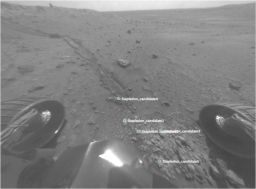 Stapledon
StapledonSpirit took this image of Stapledon with its hazard camera after driving over it this month. Of the potential candidates to be checked out up close at the Stapledon site, the rover used its instrument deployment device (IDD) and placed its alpha particle X-ray spectrometer (APXS) on candidate 2 and discovered it is more than 70% silica.
Credit: NASA / JPL-Caltech
For more than a year now, Goddard, a shallow pit that the science team suspects might be a volcanic explosion crater, and a hilly mound, named von Braun, have been on the science agenda as Spirit's next big assignments. Since these formations are located about 300 meters south of Home Plate, the shortest route for the rover would be to drive up, across the plateau, and down into the valley beyond to begin the journey south. That, ultimately, was not to be. "We tried several times to get over the little cliff onto Home Plate proper, but it didn't seem to be working so well," said Arvidson.
Spirit was sliding and shimmying sideways, due in large part, no doubt, to the fact that its right front steering wheel is frozen. It was kind of like getting a grocery cart with a locked wheel not only down an aisle, but also over a little curb first. Even before 2008 faded to black, it was pretty clear Spirit was not going to make it up onto Home, not from this spot anyway. "It was a little bit of a disappointment not to have made it up onto the top, but it was not expected," said Bruce Banerdt, MER project scientist, of JPL. "Remember, we were sitting on a 30-degree slope and that is challenging driving with six wheels, and we really only have five wheels."
By the first week of the month, Spirit was preparing to follow the original exit strategy of backing down the slope and on Sol 1782 (January 7, 2009) it took the first drive to that end. It only roved 1.7 meters (about 5.6 feet). Not much. But it was enough of a move that Spirit was able to achieve 10.2 degrees tilt of its solar arrays to take in more sunlight fuel and, as Squyres said late last month, that's just what the rover needed. The move also put Spirit closer to a knobby, crumbly-looking outcrop named for Olaf Stapledon, the philosopher-science fiction author. "It's very close to where we spent the winter," noted Arvidson. "We could always see it."
Situated in a little trough, Stapledon "looks a lot like the Gertrude Weise outcrop" down on the east side of Home Plate, Arvidson said. That turned out to be Spirit's big discovery: Gertrude Weise was 92% silica. It was a finding that underscored the presence of past water in what, the scientists hypothesize, this was either a region of hot springs region or an a volcanic area where vents or fumaroles blew out hot smoke and gases from beneath the surface.
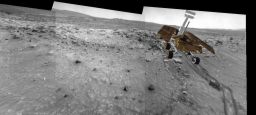 Simulated view of Spirit's winter parking spot
Simulated view of Spirit's winter parking spotOn its Sol 1793, Spirit captured a Navcam panorama containing a view of Home Plate North, the spot where it spent its third Martian winter (and all of the Earth year 2008). Michael Howard has dropped in a computer model of Spirit at the winter parking spot, providing a sense of scale and of the steep angle at which Spirit was tilted in order to catch the waning winter sunlight.
Credit: NASA / JPL / Michael Howard
So, at the team meeting a few weeks ago at Caltech, the MER science team decided that it was important to see if there were silica-rich deposits on the north side of Home Plate, as well as the east, he said. They decided that Opportunity would not only check out Stapledon, but it would purposefully drag the frozen right front wheel over it to trench it, like it had done unintentionally with Gertrude Weise.
On Sol 1793 (January 18, 2009), Spirit was up and ready. In a drive that covered about 5.5 meters (18 feet), the rover exposed now-familiar bright white soil on the northern slope of Home Plate. It took the time to snap a stack of pictures with its microscopic imager (MI) and analyze the white stuff with the alpha particle X-ray spectrometer (APXS), which detects alpha particles and X-rays emitted by rocks and soils in order to determine their chemical composition. The results? It was more than 70% silica. Opaline silica, said Arvidson, and more evidence of past water.
"It's because of the broken right front wheel that we've made the discovery of the high silica to begin with," mused Laubach. "Now we're making this amazing discovery of the high silica content of Stapledon, which we never would have done without the broken right front wheel. But the remarkable thing to think about is that Spirit, as one of the rover drivers pointed out, was in this very area 1000 sols ago. And we had no idea then what was just under the surface."
“As always seems to happens with Spirit, adversities have turned to opportunities," said Banerdt. "This stuff is popping up every where and it's looking like we have a much more extensive deposit of silica, not just like one hot spring over there on the east side,” he suggested. "This looks like it may be a stratigraphic layer or it may be an extensive region of hydrothermal activity."
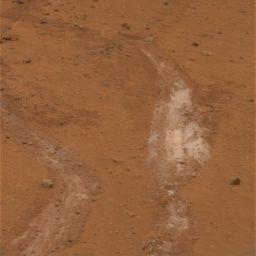 Gertrude Weise
Gertrude WeiseSpirit churned up the patch of bright-toned soil dubbed Gertrude Weise back on Sol 1150 (March 29, 2007). It turned out to be so rich in silica that scientists are convinced water had to have been involved in concentrating it. Most of the patches of bright soil that Spirit previously investigated are rich in sulfur, but this one -- roughly 20 centimeters (8 inches) wide -- has very little sulfur and is more than 90 percent silica. The rover took this approximately true-color image with its Pancam through 3 of its 13 filters on Sol 1158 (April 6, 2007).
Credit: NASA / JPL-Caltech / Cornell
There's enough science around Home Plate to keep many geologists busy, but Spirit has to rove on if it's ever going to get to Goddard and von Braun. But as the mission progresses and the rovers age, team members are coming up with new ways to use the old tools to their advantage.
Used to bolster and support the observations of the mineral seeking miniature emission thermal spectrometer (Mini-TES), which is still operating but is degraded because of all the dust that fell on the rover from the global storm of 2007 and the local storm that hit it head on last year
The stereo panoramic camera (Pancam) which is what principal investigator-photographer Jim Bell has used on Spirit and Opportunity to take all the amazing color images coming down from the rovers, is a current case in point. Beyond amazing color images, Pancam's 14 different filters can also be used for of spectral analyses of minerals on the ground and in the atmosphere.
In recent weeks, the team has discovered some consistent, though subtle features -- a downturn at the longest 1 mm wavelength of Pancam, for example, – which indicate hydration. "Melissa Rice at Cornell has done some work and it's turned out [Pancam can] be a useful tool for investigating hydration of soils as we go on about our traverse,” said Squyres. “The nice thing about this hydration index is that it does allow us, as we drive along, to use a remote sensing tool to investigate the degree of hydration of the some of the materials we are seeing – and we will do that.”
At this stage, with Spirit on something of a timeframe to get to Goddard and von Braun and have enough time to really check those two geologic formations out before having to think again about winter, this add-on value of Pancam means time saved. "Now as we drive south, we don't have to stop, drive over to a target, maneuver our instrument deployment device (IDD) on it," Banerdt pointed out. "Every stop now, with Spirit's limited power and five wheels, takes a lot of time now, a couple of weeks out of our drive schedule. We want to avoid doing that now.”
On Sol 1798 (January 23, 2009), Spirit scooted 9 meters (2.9 feet) to the east. But just two sols later, on its Sol 1800 (January 25, 2009), the rover failed to carry out its next planned drive. The rover's team subsequently received information that Spirit had indeed received its driving commands for the day, it just had not moved and it also seemed to suffer a bit of memory loss. Strangely, the anomaly occurred during the second of four wake-ups that sol, though it was during the main wake-up of the day.
There could be a lot of reasons for that, of course. The rover is a robot. It could have, for example, sensed it could not drive for some reason. Or it might have somehow become disoriented or confused.
"What the engineers saw in the data," Laubach said, "is that the rover had four successful wake-ups that day. The first was relatively early morning to gather some thermal data, then came our main wake-up where we had our drive and other activities planned," she said.
"The data we got back showed the early morning wake-up, records for the Odyssey pass wake-up and the fourth one for the first time we were going to go into DeepSleep and all occurred the way they were supposed to, but there are no records for that second wake-up," Laubach informed. If that wasn't weird enough for this straight-A rover, more unusual is that Spirit did not record the day's main activities into the non-volatile memory, the part of its memory that persists even when power is off.
At this point, the engineers have enough information to know that the rover did wake up and that it did carry out some of its assigned tasks. One of the leading theories on the table right now is that is might have been a cosmic ray event. That would explain it simply and be “no big deal,” as Squyres put it. There are other possibilities, however, and the MER engineers immediately began to troubleshoot.
Last Monday (January 26, 2009), ground control commanded Spirit to find the Sun with its camera, in order to precisely determine its orientation and things got stranger. The rover reported back Tuesday it had tried to follow the commands, but had not located the Sun. There are several elements, Squyres said, that might be responsible for that failure. "One would be a bad mission clock. One would be a bad PMA pointing. And one would be a problem with the IMU.”
 The view from Home Plate North
The view from Home Plate NorthOn Sol 1793 (Jan. 18, 2009), Spirit paused to visually record the spot where it had spent all of 2008, the steep slope off the north edge of Home Plate, the circular, volcanic plateau it has studied for the past couple of Earth years. Visible at right are the tracks Spirit left as it descended the slope, including a trench dug by its broken right front wheel. Credit: NASA / JPL / Eduardo Tesheiner
The mission clock, which runs off the rover’s batteries, is the way the rover keeps time, and just like your watch it can drift over the course of a few months or it could break. The panoramic camera mast assembly or PMA serves as the rover's "neck" and "head." It allows the cameras to rotate a full 360-degrees to obtain a panoramic view of the Martian landscape or, in this situation, move to point to the Sun. The IMU (inertial measurement units) is a critical, fiber-optic navigational aid that senses acceleration and angular motion or tilt of the rover and converts this data to outputs that are then used by the rover’s control systems for guidance. The IMU also positions the rover's high-gain antenna in combination with its Sun sensor.
“We believe that the mission clock is good,” Squyres continued. “We believe that the PMA pointing is good. We just went through some assessing a downlink where we looked at the performance of the IMU and the gyros appear fine and the accelerometers may or may not have an issue. We're still looking into that." Even if there is an issue with Spirit’s accelerometers, it is "minor enough” that the team is confidant in allowing the rover to drive,” Squyres added.
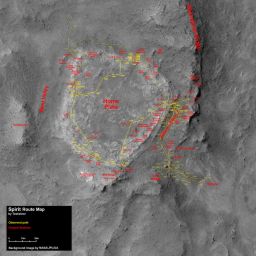 Spirit route map to Sol 1782
Spirit route map to Sol 1782On Sol 1782 (Jan. 6, 2009), Spirit inched downward from its third winter haven, just off the north edge of Home Plate. It was the first significant motion in nearly an Earth year. The rover is now heading toward the south and its next major desitnation.
Credit: NASA / JPL / UA / Eduardo Tesheiner
So, today, if all goes planned Spirit – which is just 16.2 meters from its winter parking spot – will attempt to double its distance with a 15-meter drive that just may put the rover back on top of Home Plate by way of an "onramp" a couple of meters to the east of where it's been for the past week, on the slope of Home Plate.
“This particular onramp is not one we have gone up before,” said Squyres. “This one is quite close and we're going to try this one and see how it goes. If it works, great. We're up on top of Home Plate. If we don't have some pretty quick success with this ramp, we're not going to waste a whole lot of sols trying to fight our way up.” If it doesn't work, then Spirit will go around Home Plate, he said, to the onramp about 40 meters (about 131 feet) away, which they know the rover can ascend with five wheels because that’s where it has roved onto the volcanic formation that way “several times before.”
With the priority now being getting to von Braun and Goddard, Spirit’s focus in coming sols will be on driving. “We're not going to be jamming on the brakes and stopping a whole lot at least between here and the south edge of Home Plate,” Squyres confirmed. “It would take something truly extraordinary to get us to stop for anything at this point.”
According to the MER team’s current planning projections, Spirit should be able to get to its next major destination and have on the order of six weeks of science activity before the team will have to start thinking about the next Martian winter.
Opportunity from Meridiani Planum
Last September, Opportunity launched on its latest prime directive: drive as quickly as possible to Endeavour Crater, a crater 20 times the size of Victoria Crater and then some 12 kilometers away, the same distance it had traveled in nearly five years of roving Mars. It’s a trek that Squyres projected could take two years. The rover hit the plains roving long and far, not wasting any time.
Opportunity is also, however, conducting several focused science campaigns amidst all those 100+-meter drives. Actually, it began the New Year quietly finishing up some investigations on chosen samples of bedrock, labeled Candia, and soil, Minos, in an area dubbed Crete. These are the first measurements in a series of measurements that will be taken every kilometer or two all the way to Endeavour Crater, for what ultimately will be a rich, systematic study of the surface terrain.
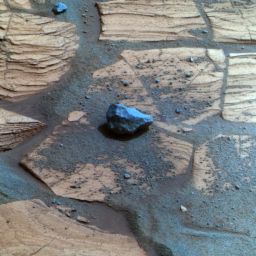 Santorini
SantoriniOpportunity used its Pancam to take this false color image of Santorini, the cobble it studied up close during solar junction. The rover snapped the picture on its Sol 1713 (Nov. 17, 2008), the same day it nudged up to it and puts its instrument deployment device (IDD) on its surface.
Credit: NASA / JPL-Caltech / Cornell
Also on its agenda is the cobble campaign, a study of the small rocks that are scattered around the Meridiani plains, and continued research on the windblown ripples.
The first cobble Opportunity looked at close-up -- Santorini – which it analyzed for the first two weeks of December during solar conjunction – turned out to be a meteorite. But the team expects others will be rocks that were hurled up by meteor or asteroid impacts from the “underlying ancient Noachian basement,” as Ray Arvidson calls it. “It’s a way to sample things coming from space and the material excavated underneath the layered sedimentary rocks,” he pointed out.
The ripples now “conclusively” look like they have formed by easterly winds, Arvidson continued. “That's interesting, because it's a pretty dominant landform from the east, but in today's environment, we're not seeing very strong winds coming from the east. We want to make sure we really understand what's happening to the wind directions that formed these deposits as we get into the kind of lee of Endeavour.”
Just as it was finishing work in the Crete area, early in January, the z-axis encoder on the rock abrasion tool (RAT) broke. While the MER team detected the failure on Sol 1759 (January 4, 2009), it wasn’t until the end of the first week of the month, on 1762 (January 7, 2009), that engineers were able to conduct the necessary diagnostics to confirm the failure. It came as no surprise. The other encoder lines, which sense the rotate and revolve axes, broke last year and the Z-axis encoder was next in line to go. “There's a flex cable on the arm that has a series of traces there are sort of failing one by one and we knew the next one to go was going to be the z encoder,” said Squyres.
The encoders are, basically, the sensors that tells the rover and the team how far the RAT has moved in each of those directions. The signals move along the traces or wires on the flex cable, which goes through the elbow and shoulder joints to the rover computer. “We think that one of the cables in one of the joints has started to crack and that crack is moving in from the edge,” elaborated Bruce Banerdt.
The good news is that the next half dozen conductors of this cable are unused dummy wires, Banerdt added, “so as those things get broken they're not going to affect rover operations any.” The other good news is that the engineers already have a workaround or, in other words, a way to use the RAT without these encoders.
“Instead of using the encoders, which are a digital signal that we can monitor, we actually use the rise in motor current as we run into something to trigger turning off the motors and detecting where the surface is. When the motor current rises, we know it's straining against a solid object and we can tell it to just turn off automatically. Then we can back off and do everything we have to do. We have to sort of use it a little bit blind and it takes a different set of commands, so we want to put ground in the loop when we do it, but we can still use the RAT.”
Still, they have to test that workaround. That, right now, is the rub. The Surface System Test Bed (SSTB, aqua Indoor Mars Yard, or the Sandbox) is being renovated and the SSTB rover, a high-fidelity engineering model of the Mars Exploration Rovers, or “our hangar queen rover,” as Banerdt put it, is in a box.
The economic downturn has impacted everything, including Mars exploration. The economy combined with the rover’s longevity forced the Mars – despite their robot star status -- to take on a roommate at JPL. The renovation will essentially cut the space in half to make room for the Mars Science Laboratory (MSL).
“They're going to partition the SSTB in half and have the MSL arm test bed in one half and our rover in the other half,” Banerdt informed. It’s out with the old orange, dusty gravel and in with a railroad car full of new crushed garnet, after a thorough cleaning of the walls, floors, and ceiling.
Although the rehab is behind schedule, “we don't have anything we need to RAT right now anyway,” said Squyres.
Before taking off for Endeavor again, Opportunity on Sol 1766 (January 11, 2009) and one on Sol 1771 (January 16, 2009) conducted some more shake-tests of the top mirror on its Mini-TES in an attempt to shake loose some of the dust that is now completely obscuring the optics. Although they vibrated the mirror more vigorously and for longer periods, there was no noticeable change, said Laubach.
Since then, it's been all about driving, although Opportunity did sneak in a couple of “drive-by shootings.” No, the rover has not discovered any Martian gangs. These are quick “imaging campaigns on the fly,” as Banerdt described them, of shallow craters the rover passed along the way.
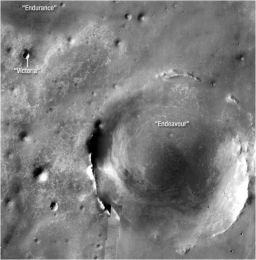 Opportunity's next big destination
Opportunity's next big destinationThe MER team has chosen a a crater more than 20 times wider than Victoria Crater as Opportunity's next destination. The rover began the long, 12-kilometer (about 7.5-mile) journey -- which p.i. Steve Squyres estimates will take about 2 years, with science stops along the way -- on Friday, Sep. 26, 2008 with a 152-meter drive. The crater, which is to the southeast of Opportunity's location at Victoria, dominates this orbital view from the Thermal Emission Imaging System (THEMIS) camera onbaord Mars Odyssey orbiter. Victoria is the most prominent circle near the upper left corner of the image. This view is a mosaic of about 50 separate THEMIS visible-light images.
Credit: NASA / JPL-Caltech / ASU
During the third week of January, Opportunity drove 104.1 meters on Sol 1770 – (January 15, 2009), and followed it on Sol 1774 (January 19, 2009) with a 115.4 meter-drive. Then, on Sol 1776 (January 21, 2009), it drove 29.9 meters to approach and “shoot” Ranger Crater, a relatively fresh crater, the team thinks, about 10 meters across.
Just four Martian days later, on Sol 1780 (January 25, 2009), Opportunity took off on a 50.5-meter drive to take pictures of Surveyor Crater, another shallow crater about 10-meters in diameter. From the imaging and other data collected on the Meridian craters, the team will create a catalogue of craters revealing their different levels of degradation. This will help inform planetary scientists about crater morphology and the processes that degrade these things over time.
In addition, it the scientists can see and determine crater density and also analyze degradation and/or erosion, it should help them to better date the surface better. “You have to accumulate a lot of information before it becomes really useful,” noted Banerdt. “It's not home run science. It's more stamp collecting science.”
As the team “collects stamps,” among other things, along the way, Opportunity is going for the home run of Endeavour Crater. If it can make it, the crater, which is 20 times the size of Victoria, promises to take them further back in Martian time. On Sol 1782 (January 27, 2009), Opportunity again put the pedal to the metal and knocked off a 130.6-meter drive. Two sols later, the rover ripped off an 87-meter drive, pushing its mission total mileage to 14,135 meters. And if the rover roves as planned today, Opportunity will put another 160 meters under its six wheels today.
“It's drive, drive, drive,” said Squyres.
Support our core enterprises
Your gift today will go far to help us close out the year strong and keep up our momentum in 2026.
Donate

 Explore Worlds
Explore Worlds Find Life
Find Life Defend Earth
Defend Earth



